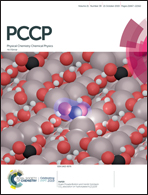Synthesis of a photo-responsive single-walled nanoscroll and its photo-reactivity in a nano-layered microenvironment†
Abstract
A photo-responsive nanoscroll composed of niobate nanosheets and a polyfluoroalkyl azobenzene derivative (C3F-Azo-C6H) is one of the most interesting layered materials because the reversible winding and unwinding motion could be efficiently induced by photo-irradiations. Previously, we have studied a double-walled nanoscroll (DWNS) of niobate that could be synthesized by the intercalation of a cationic polyfluorinated surfactant only into the interlayer I of the layered niobate among the two interlayers, I and II. In this study, we have successfully synthesized another novel photo-responsive single-walled nanoscroll (SWNS) of niobate by a stepwise guest–guest ion-exchange method. All niobate nanosheets that were exfoliated at both interlayers I and II were efficiently converted to nanoscrolls by the intercalation of C3F-Azo-C6H. The synthetic yield has been quantitatively estimated. Though the photo-isomerization reaction of C3F-Azo-C6H was induced in the SWNS, its photo-reactivity was the lowest when compared with those of the nanosheet-stacked film and the DWNS. The photo-reactivity of C3F-Azo-C6H decreased in the order of DWNS > nanosheet-stacked film > SWNS. The different flexibility of the layered miroenvironment might influence the photo-reactivity of C3F-Azo-C6H in the niobate hybrid. The SWNS exhibited a reversible expansion and shrinkage of its interlayer spaces upon photo-irradiation, while the winding and unwinding motion was not observed, contrary to the DWNS. The direction of the expansion and shrinkage of the interlayer of the SWNS was opposite to those of the nanosheet-stacked film and the DWNS. Based on the experimental results, the tilt angle of C3F-Azo-C6H against the nanosheet surface and the matching structures of the top and bottom surfaces of the nanosheet could be the probable key factors that control the photo-reactivity of C3F-Azo-C6H in the layered microenvironment; the morphological changes of the nano hybrids was also discussed.

- This article is part of the themed collection: 2019 PCCP HOT Articles


 Please wait while we load your content...
Please wait while we load your content...